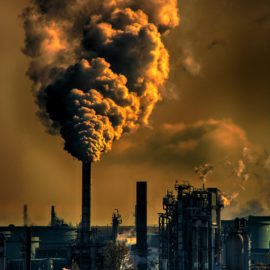
Emissions. That is the common complaint of the refineries in the state. Sadly they are not doing well and the residents suffer.
Four Louisiana refineries are among a dozen nationwide that last year released the cancer-causing chemical benzene at levels higher than federal limits, according to a new report from a national environmental nonprofit. The Environmental Integrity Project found that PBF Energy’s Chalmette Refinery in Chalmette; Valero’s St. Charles refinery and the Shell Norco Manufacturing Complex in Norco; and the Phillips 66 Lake Charles refinery in Westlake all emitted more than 9 micrograms per cubic meter of benzene at their fencelines in 2021. Benzene, which the Environmental Protection Agency considers a “known carcinogen,” is a gaseous compound found in gasoline and other petroleum products. It is known to cause nervous and immune systems damage and leukemia, and companies must create plans to reduce benzene emissions when those emissions exceed the EPA’s 9-microgram limit.
NOLA.com
These four were the worst but six others were not far behind.
Another six Louisiana refineries emitted more than 3 micrograms per cubic meter of benzene at their fencelines, the nonprofit found. They include CITGO LCMC, Westlake; ExxoonMobil Refinery, Baton Rouge; Calumet Shreveport; Phillips 66 Alliance, Belle Chasse; Delek Refinery, Krotz Springs; and Placid Refining, Port Allen. Though the lower benzene level is not mentioned in the EPA’s regulations, it still exceeds a California emissions standard that was based on research linking benzene exposure to reduced blood cell counts and other negative impacts in humans, researchers said. The EPA has also said that there is a new case of cancer among every 100,000 people exposed over their lifetimes to between 1.3 and 4.5 micrograms of benzene per cubic meter. California health experts estimate that 3 micrograms of exposure over a lifetime can result in 8 new cancer cases for every 100,000 people. “EPA and the oil refining industry really need to do more to crack down on these benzene emissions, because the fenceline concentrations at too many refineries are high enough to pose a potential threat to neighborhoods that are close by,” said Eric Schaeffer, the executive director of the Environmental Integrity Project.
EPA Region 6 did not respond when asked if plans to curb the emissions had been submitted as required.
The EPA’s Region 6 office, which oversees Louisiana, did not respond on Thursday to a request for information on whether the companies cited in the report had submitted emission reduction plans, as required by the agency’s regulations. But a spokesperson for the Shell Norco complex said the refinery was working with the EPA and the Department of Environmental Quality to curb its emissions. “Shell Norco Manufacturing Complex Site actively monitors benzene emissions at 35 stationary locations along our fenceline,” said Curtis Smith. Although the majority of Shell’s emissions readings are below the EPA’s limit, “there have been periods where the fenceline emissions are elevated (due to unit upsets) that impact the wastewater system,” he said. A Phillips 66 refinery spokesperson also said Phillips was working with federal officials to control its emissions.
The director of the non-profit is also with the Bucket Brigade who have sued some of the same plants.
Schaeffer, the nonprofit director, is a former director of civil enforcement with the EPA. His group the Louisiana Bucket Brigade sued the EPA in 2012, and the agency changed its rules three years later to require fenceline benzene monitoring as a result. Schaeffer’s group’s data was culled from fenceline emission reports submitted to the EPA by dozens of refineries across the country. Still, the EPA’s new rules have have some holes, Schaffer said. They do not require similar monitoring for benzene at fencelines of chemical plants, some of which are next to refineries and whose emissions could be measured at the refinery fenceline stations. More importantly, the rules don’t require emissions monitoring within neighboring communities, many of which are majority Black, Hispanic or low-income.
Chalmette is a good example of these problems.
An example of those problems can be seen with the Chalmette Refinery, ranked sixth on the list of 12 refineries violating the 9 microgram standard. The company measured benzene at higher levels than the EPA action level in each of the four years it has conducted fenceline monitoring. Its 2021 level was an average 12.6 micrograms, and the facility’s long-term average of the highest fenceline concentrations from 2018 through 2021 was 13.7 micrograms. The facility sits near other refineries and chemical plants, which also emit benzene. One or more of the refinery’s fenceline monitors detected concentrations of benzene greater than 29 micrograms per cubic meter for four weeks in 2021, which is considered the acute minimal risk level by the federal Agency for Toxic Substances and Disease Registry. According to the EPA’s measures of population demographics, 61% of the people living within 3 miles of the refinery are people of color and 41% are low income. In a Thursday statement, Chalmette said it is investing in new technology that will lower benzene emissions below the EPA’s limit, and that the Environmental Integrity Project’s report inflates its benzene emissions. “The EPA’s action level of 9 micrograms per cubic meter does not mean there is a health risk to the public, nor is it a measure of benzene levels in the community,” the statement said.
Valero St Charles is another good example.
Valero’s St. Charles refinery was ranked fourth on the list of 12 highest emitters, with 14.1 micrograms per cubic meter in 2021. And at least one fenceline monitor measured a two-week average concentration greater than 29 micrograms per cubic meter, the level considered acute. But more problematic was an average reading of 300 micrograms per cubic meter during the two-week monitoring period that ended on Sept. 6, 2021, which was after Hurricane Ida disrupted the plant’s operations. “That’s very close to the level where the National Institute for Occupational Safety and Health says you should be wearing respirators,” Schaeffer said. “And that’s the kind of exposure information that needs to get out quickly. The requirement to fix these kinds of problems should apply not just to the long-term averages, but to this kind of short-term spike that can be very dangerous.” About 30% of residents within 3 miles of the plant are people of color, and 21% are low income, according to EPA. Valero’s record in the previous three years was significantly better, with fenceline emissions measured an average 3 micrograms or less. The company did not respond to a request for comment on the report.
The overall “winner” was in Galveston.
The refinery with the highest benzene emissions in the nation was Marathon’s Galveston Bay/Texas City facility, which reported 37.8 micrograms in 2021, almost double its 2020 average of 19.6 micrograms. The facility had two-week average concentrations greater than 29 micrograms for 18 weeks in 2021, with a highest concentration of 275 milligrams during the two weeks ending Oct. 13.
They get cited, they get fined, they get taken to court but they still pollute. The money they make.


